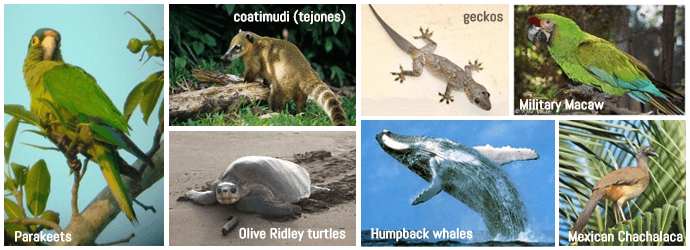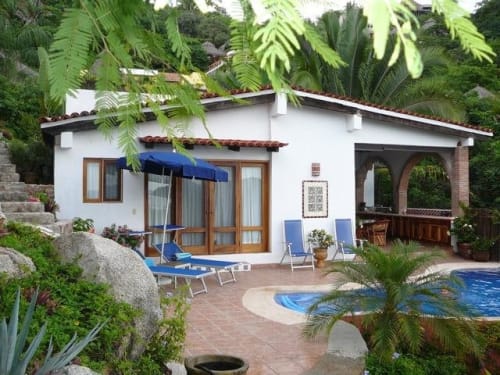SayulitaLife.com members can easily save favorites for vacation rentals, local businesses, real estate and more.
Sign In Create free accountList Your Property
Sayulita Mexico's Wildlife: Guide to Exotic Fauna & Sightings

Encounters with animals will be rare, but foxes, coatimudi (tejones), raccoons, armadillos, opossums, skunks and squirrels may occur.
Land-crabs, spiders, geckos, iguanas and other assorted lizards are all around. Usually only geckos are present indoors (they should be welcomed as they eat flying insects) but depending upon where you live (or are staying), snakes and scorpions can be more prevalent. The jungle and gardens will have land-crabs - they are harmless and non-edible (hence their numbers) and crawl under everything.
Sayulita is surrounded by tropical jungle and has many plants and trees throughout the village and "bugs" are forever present. At night, light will attract moths, beetles and other flying insects. Suggestion - to avoid being buzzed, do not sit under or next to a lamp, or have a separate lamp with a brighter bulb elsewhere in the area. Some moths and beetles are large and beautifully marked; moths can have wingspans the size of a hand; scarab and horned beetles are just a little smaller than a pack of cigarettes. Spiders vary from the "normal" household variety to the truly exotically-colored. Black widows and tarantulas are generally not found in this part of Mexico. To cut down the number of mosquitoes, make sure there is no standing water around the house. Dawn and especially dusk are the worst times for getting bitten. Mosquito repellant is readily available in any Sayulita pharmacy.
In the winter months, the Humpback whales use the protective waters of Bahia de Banderas to raise their calves. It is amazing to be up close to the largest mammal on the planet. You can hire a boat in Sayulita, Punta de Mita, or in Vallarta for this exciting excursion. In the Bahia de Banderas, all the boats work together to make sure that you see a whale on your trip. See our Tours and Adventures page.
Pacific Green and Olive Ridley turtles come ashore along this coastline (in Sayulita, only the Olive Ridley) to lay their eggs June through October and hatchlings emerge September through December. A group of volunteer residents patrolled Sayulita's north beach in 2008 and brought over 100,000 eggs from 120+ nests to a safe and guarded area and held controlled releases through the hatching season. The obstacles are so numerous for baby turtles that only about 1 in 1,000 survives to adulthood. Turtles may be observed in the sea while snorkeling, kayaking and surfing.
See Sayulita Fishing to learn more about the local fish species.
More than 300 species are to be found along the coast and in the mountains around Sayulita – 113 species were identified by 2 ornithologists during November. Migration accounts for the great variety during the winter months compared to summer. Some of the largest birds you will see are high over head, Magnificent Frigatebirds, and others will skim the water Brown Pelicans, while vultures and crows can been seen over the trees. The most common birds seen are gulls and the purple black Grackle with its sharply pointed beak, squewed tail and its amazingly wide vocal range including the ability to mimic - especially cell phone tones!
To view birds open your eyes and look around and up into the skies above Sayulita. Gulls and sea-shore birds can obviously be found along the beach but fresh or sweat water birds are common at the mouth of the town river and nearby streams. Around town bushes and trees host a wide variety of birds. Pairs or small flocks of raucous Orange Fronted Parakeets (pictured) (which look more green with a yellowish chest) fly from tree to tree, while another noisy local can be seen just before sunset as squadrons of Yellow Winged Cacique flock to a particular tree in the garden of a house at the N.E. corner of the baseball field (opposite the beer depository).
Hummingbirds, wood-peckers, flycatchers, orioles, doves, hawks, thrushes and sparrows are common sights. A walk along jungle paths will offer more and different habitats but viewing is more difficult however by no means impossible. With patience and vigilance colorful Russet Crowned Motmots and Black Throated Magpie Jays can be seen and the turkey-sized West Mexican Chachalaca (pictured) are not uncommon; all three are endemic to the Sayulita region.
In the jungle you may see Lilac Crowned Parrots and even the Military Macaw can only be found in the deepest undisturbed jungle. For hiking and other fun adventures check our tours and adventures page.
Since you are here...
SayulitaLife.com rental prices are the lowest anywhere. Guaranteed!
Booking via SayulitaLife.com directly supports the local community. We are a local, family-owned, community-oriented business that supports all local charities and organizations.
All businesses/rentals have been physically verified by our staff, and in most cases, we know the owners personally.





